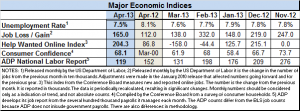 Temp staffing had its strongest month in two years, adding 30,800 new jobs in April. That accounted for almost one-in-five of the new jobs added to the U.S. economy last month.
Temp staffing had its strongest month in two years, adding 30,800 new jobs in April. That accounted for almost one-in-five of the new jobs added to the U.S. economy last month.
The U.S. Department of Labor this morning said that on a seasonally-adjusted basis, 165,000 new non-farm jobs were created last month. The unemployment rate also declined slightly to 7.5%, even as the size of the workforce ticked up slightly. (It is still lower than at any time in more than three decades.)
The government also adjusted up its initial numbers for both February and March, increasing the new job estimates by a combined 114,000. With the revisions, job growth in the first quarter totaled 618,000. That’s just slightly behind the 208,000 monthly average during all of last year.
The April job growth was better than analysts were expecting. Before the release in Washington, surveys of economists showed them expecting job growth to be in a range between about 125,000 and 155,000.
Temp employment in just the last two months has jumped by 56,300 jobs, according to the revised Labor Department numbers. Non-seasonally adjusted counts are even higher; 119,800 temp jobs were added in March and April.
In addition to the temp sector, April’s job growth came in several other areas:
- Hospitality jobs took a big jump, adding 43,000 overall, with 37,900 of them at restaurants and bars;
- Retail added 29,300 jobs, nearly half at general merchandise stores. Department stores added 7,900 new workers;
- Health care jobs grew by 19,000;
- Professional and Technical Services added 22,800 jobs. The category includes legal, accounting, computer professionals, architectural jobs, and management and consulting services.
Government and the goods-producing sector were the soft spots. Government at all levels lost 11,000 jobs; 8,000 came from the federal workforce. Construction was down 6,000 jobs and manufacturing was flat.
While the official unemployment rate declined during April, and is now .4 points lower than it was in January, by another measure, the so-called U-6 report, rose slightly to 13.9%. This report not only counts those who meet the official definition of unemployed, but also includes those working part-time because they can’t find other work, and those out of a job and looking for work, but who didn’t look during the April survey period.
Overall, those 13.9% translate into 21.9 million workers.
One other component of the government report economists watch as a sign of future employment development is the length of the average workweek. According to the report, it decreased by 0.2 hour to 34.4 hours. Within manufacturing, the workweek decreased by 0.1 hour to 40.7 hours, and overtime declined by 0.1 hour to 3.3 hours. The average workweek for production and nonsupervisory employees on private nonfarm payrolls decreased by 0.1 hour to 33.7 hours.